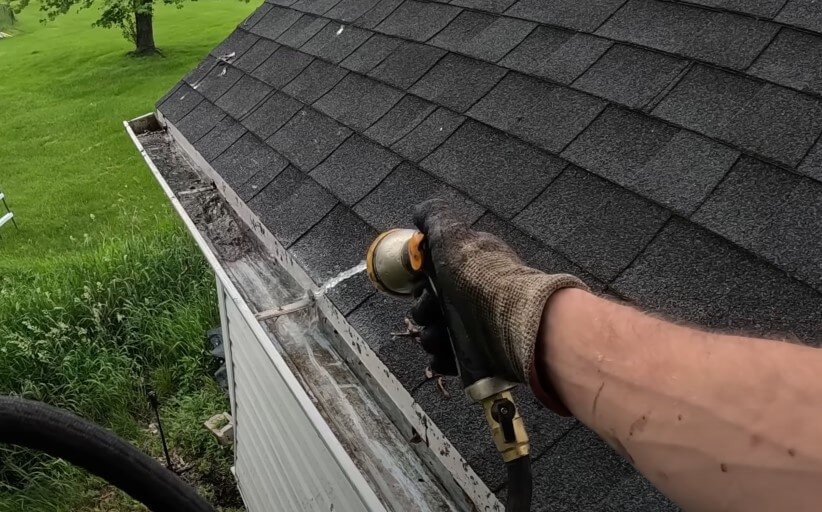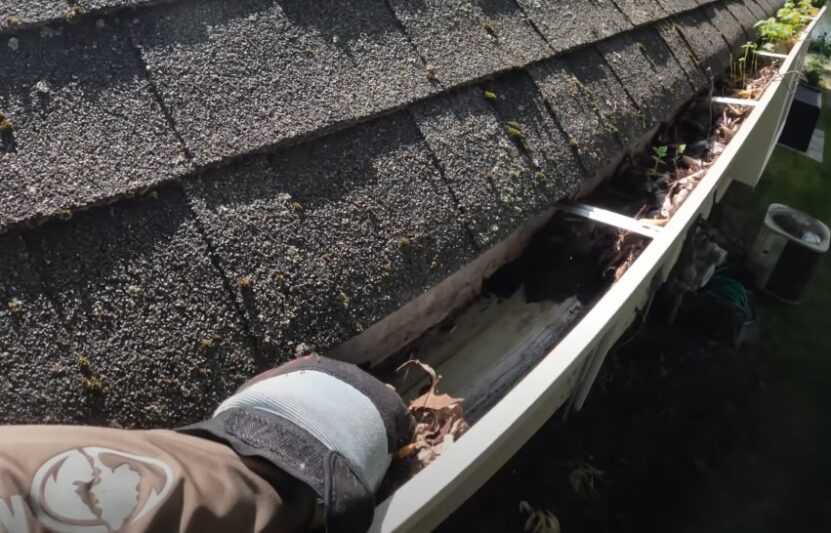When a storm is brewing, you probably think about hauling patio chairs into the garage, charging your phone, or making sure the generator still fires up. Maybe you’ve even stocked the pantry or taped the windows. But there’s one part of your home quietly waiting, shouldering more responsibility than most people realize, and that’s your gutters.
They’ve got the front row seat to every drop of rain heading your way. And if they’re not ready, the damage won’t wait politely at the door. It’ll sneak in through the walls, soak the foundation, and flood your basement before you even hear the wind howl.
Let’s talk about what your gutters are dealing with, and why getting them storm-ready might be one of the smartest moves you make as a homeowner this year.
Quick Gutter Prep Cheat Sheet
| Maintenance Task | Why It Matters | What You’ll Need |
| Clean Gutters & Downspouts | Prevent clogs and overflow | Gloves, trowel, hose, plumber’s snake |
| Seal Leaks & Cracks | Stop water seepage into walls and roofline | Gutter sealant, hose |
| Tighten Components | Avoid detachment in high winds | Screwdriver, drill, gutter brackets |
| Check Slope | Ensure smooth water flow | Level, brackets, spacers (if needed) |
| Inspect Fascia & Soffits | Provide solid support for gutters | Hammer, replacement boards, fasteners |
| Trim Trees, Secure Yard | Minimize damage from falling or flying objects | Pruners, rope, storage bins or tarp |
Pre-Storm Gutter Prep – What To Do Before the Skies Open Up

Getting your gutters storm-ready isn’t complicated. But it’s got to be thorough. One missed blockage or loose bracket can cause major problems when the rain starts falling sideways.
Here’s how to make sure your gutters are in fighting shape:
1. Clear Gutters and Downspouts
Goal: Let water move freely through the system.
- Grab gloves, a sturdy ladder (with a stabilizer if you have one), and a trowel.
- Remove leaves, twigs, roof granules, or any other debris by hand.
- Once the gutter channels are cleared, flush them with a garden hose.
- Run water through downspouts. If it backs up or trickles out, a plumber’s snake or wet/dry vacuum can help clear the jam.
Pro Tip: Clogs often build at the elbow of the downspout. Don’t assume the whole pipe is clear just because the top looks good.
2. Seal Up Leaks and Cracks
Goal: Stop leaks before they become water intrusion points.
- With water still flowing, look closely at seams and joints.
- Use a waterproof gutter sealant for small holes or seam gaps.
- For anything larger—rust spots, crushed areas, broken joints—consider replacing that section entirely.
Pro Tip: Pay extra attention around corners and end caps. They’re notorious leak zones.
3. Tighten Everything Down
Goal: Make sure high winds don’t rip your gutters off the house.
- Inspect all fasteners holding the gutters to your fascia. Brackets and hangers should be tight, evenly spaced, and not pulling away.
- If any parts are loose, re-secure them with screws designed for exterior use.
- Check for sagging—sections that dip or bow under their own weight likely need an extra bracket.
4. Double-Check the Slope
Goal: Ensure water doesn’t sit or pool in the trough.
Gutters should slope about ¼ inch for every 10 feet toward the nearest downspout.
- Grab a level and check multiple points along each gutter run.
- If water is pooling in certain spots, you might need to adjust the brackets to restore proper pitch.
Pro Tip: Water that lingers in a low spot becomes a magnet for debris and insects, even in light rain.
5. Inspect Fascia and Soffits
Goal: Confirm that your gutter system is mounted to something solid.
- Look for soft spots, rot, or peeling paint where gutters meet the roofline.
- If the fascia board is weak, no amount of reattaching the gutter will solve the problem—it needs to be replaced or reinforced.
- Check that soffits (the underside of the roof overhang) are sealed and intact.
Pro Insight: During a heavy downpour, fascia boards can absorb water like a sponge if they’re already compromised, leading to full gutter collapse.
6. Deal With External Hazards

Goal: Keep your gutters safe from outside threats.
- Trim any tree branches hanging over or near the roof.
- Remove hanging vines, nests, or other obstructions.
- Secure or store outdoor items like grills, chairs, toys, and planters.
Lednor Home noted that many Florida homeowners who suffered gutter damage during Hurricane Ian didn’t have clogged gutters—but rather had gutters that were struck by heavy tree limbs or unsecured debris.
Mistakes That Will Cost You
Even if you mean well, certain missteps can backfire when prepping for a storm. Watch out for:
- Waiting too long: Gutter prep isn’t a last-minute task. If the radar’s already red, it might be too late to make meaningful changes.
- Only cleaning the visible parts: A clean gutter trough won’t help if the downspout’s jammed halfway down.
- Skipping regular maintenance: Once or twice a year is the bare minimum. Seasonal cleanings—in spring and fall—are ideal.
- Ignoring small fixes: A pinhole leak might not seem urgent. But during a storm, it can spray water where it doesn’t belong, soaking insulation or siding before you even spot it.
Why Gutters Deserve More Credit Than They Get

Gutters don’t just catch the rain. They control the flow of it—keeping thousands of gallons of water from pouring down your siding, pooling around your foundation, or seeping into your roofline.
When they’re working the way they should, you hardly notice them. When they’re not… it’s a different story.
What’s at Stake?
- Foundation damage: Water that doesn’t drain away from your home starts to collect around the base. Over time, that can weaken the foundation or lead to cracks, leaks, and shifting soil.
- Roof and siding damage: Overflow from clogged gutters runs back toward the house, rotting fascia boards, damaging soffits, and causing stains or mold on siding.
- Flooded basements: One of the most expensive and frustrating consequences of gutter failure is water coming in through the lowest point of your house.
- Ruined landscaping: Even your lawn takes a hit. Poor drainage causes erosion, drowns plants, and washes mulch and soil out into the street.
NOAA reported 28 billion-dollar weather disasters in the U.S. in 2023. As storms grow more frequent and unpredictable, the systems that protect your home need to be stronger and smarter than ever.
When to Bring in the Pros
There’s no shame in calling for help. In fact, there are times when doing so is the smartest—and safest—option:
- Your gutters are old or badly damaged: That’s when scheduled gutter maintenance and repairs can save your fascia board from costly rot.
- Your home has multiple stories: Leave the high ladders and steep rooflines to someone with the gear and insurance.
- You want to install gutter guards: They can reduce maintenance by keeping leaves and debris out, but only if installed properly.
Companies like Rain Gutters Solution or Stern Gutters offer storm-readiness services and inspections. A pre-season visit could save you thousands in the long run.
What It All Comes Down To
Your gutters don’t get much glory. But when a storm barrels through, they’re one of your home’s first lines of defense. Quiet, humble, and usually ignored—until they fail.
The good news? You don’t need to be a contractor or a handyman to make sure your gutters are up to the job. Just a ladder, a little time, and a bit of elbow grease can go a long way.
Storm prep isn’t just about reacting—it’s about getting ahead of the curve. Because once the rain starts falling, there’s not a whole lot you can do from inside. But if your gutters are ready, your home will be too.
So don’t let the next storm catch you off guard. Grab your gloves, check those fasteners, and clear the gunk now—before your gutters have to raise the alarm the hard way.









